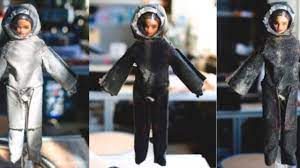Barbie dolls dressed as space explorers have proven to be valuable assets in solving the lunar dust problem faced by scientists.

Recent experiments using Barbie as a test subject have revealed a novel and effective technique for removing Moon dust from spacesuits, potentially aiding future space exploration.
Barbie’s versatility as a character has been showcased throughout the years, portraying roles like a US president, a Nobel Prize-winning physicist, a Supreme Court Justice, and even a mermaid in Greta Gerwig’s 2023 film.
One of her most iconic roles is that of a space explorer, where Astronaut Barbie was taking children on imaginary space adventures even before NASA’s own astronauts set foot on the Moon in the 1960s. This trailblazing depiction of space exploration came 13 years before NASA welcomed female astronauts into their program.
Barbie’s Role in Unraveling the Lunar Dust Cleaning Challenge
Lunar dust presents a significant issue for space exploration due to its “ubiquitous, abrasive, and electrically charged” nature, as explained by Ian Wells, a graduate researcher at Washington State University.
The microscopic particles cling stubbornly to astronauts’ spacesuits, posing difficulties in cleaning them off. The traditional cleaning methods used during the Apollo missions were ineffective, leading to potential damage to the suits’ seals.
Apart from suit damage, inhaling lunar dust can cause serious harm to the lungs, with Wells likening it to “breathing ground-up fiberglass.” Considering the future plans of returning to the Moon, finding a new cleaning technique to protect spacesuits and astronauts is of utmost importance.
Inspired by the “Leidenfrost effect,” the team from Washington State University experimented with Barbie and liquid nitrogen. By coating Barbie, dressed in a tailor-made spacesuit, with volcanic ash and spraying her with liquid nitrogen, they discovered a remarkable effect similar to a “cryogenic carwash.”
This innovative technique utilized a combination of the Leidenfrost effect and the “boiling liquid expanding vapor explosion” (Bleve) effect, successfully removing lunar dust from the spacesuit.
Sourcing real Moon dust was restricted by legal regulations, so volcanic ash from Mount St. Helens was used as a substitute for testing. The liquid nitrogen spray, functioning as intended, propelled some Moon dust into the surrounding air.
However, the challenge remains in devising a method to remove the propelled dust from the air before astronauts take off their spacesuits to prevent inhalation.
Success Rate
The study, published in Acta Astronautica, reported a remarkable 97% and 98.4% removal rate of lunar dust by mass in ambient and vacuum environments, respectively. Encouraged by these positive results, the team further tested the liquid nitrogen spray on scale models, ensuring its effectiveness.
Barbie played a pivotal role as a test subject, demonstrating high dust removal efficiency with minimal damage to the spacesuit.
Barbie’s surprising involvement in solving the lunar dust problem highlights the importance of innovative approaches in space exploration. As scientists continue their research, they aim to replicate the Moon’s environment more accurately and eventually test the technique on human astronauts.
Although Barbie, affectionately named “Rosie” in this research, may have retired from future experiments, her contribution illustrates how even a simple plastic toy can play a significant role in advancing celestial exploration.